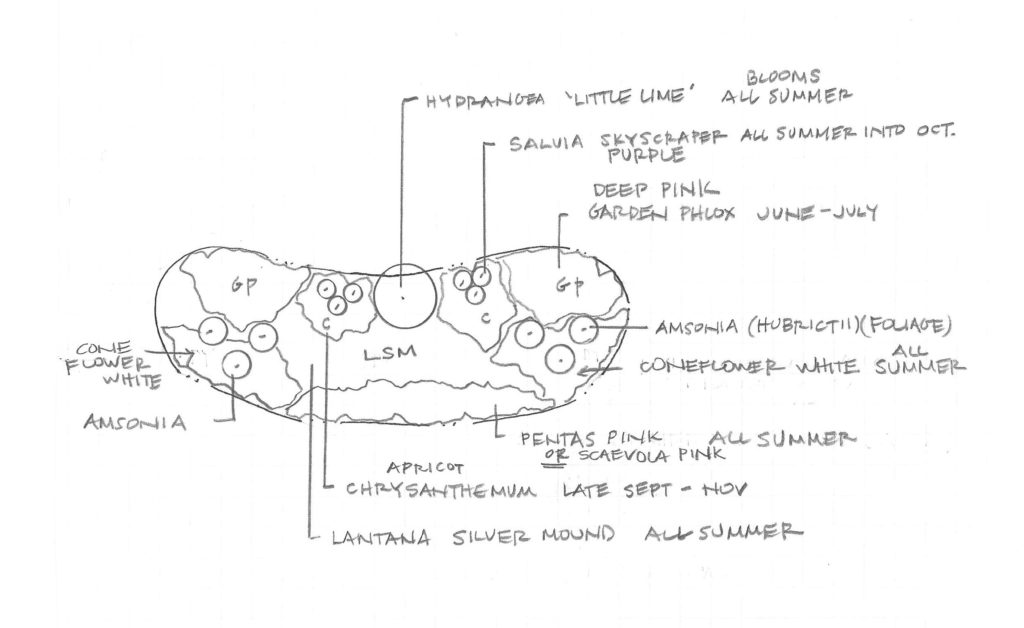
Garden design may seem like a mystery for anyone new to gardening. It’s a bit like trying to understand why an interior designer chooses geometric print wallpaper instead of a stripe. When making any type of design decision, it helps to know what you like and what will work for a particular situation.
For this post, I’ve drawn a design plan for a summer border ideal for an open sunny area, such as an island bed surrounded by grass. Deep pink garden phlox, one of the plants used in the back of the bed, demands good air circulation in humid areas of the South, so I only use it in areas where it will have plenty of room to thrive. I love this tall form of phlox for summer flower beds, and in this design scheme, it’s the plant that influenced the other decisions I made in regard to color and form.
I’ve listed all of the plants for this design below, by their common name and variety:
Perennial garden phlox ‘Maiden America’ (bright pink)
Shrub panicle hydrangea ‘Little Lime’ (chartreuse green, changing to white, then fading to rose)
Perennial chrysanthemum ‘Sheffield Apricot’ (pale rosy apricot)
Perennial salvia ‘Skyscraper Purple’ (fuchsia bloom with purple calyx)
Perennial amsonia (hubrichitti) (soft green needles turning to yellow in Fall)
Perennial coneflower ‘White Swan’
Annual lantana ‘Silver Mound’ (white)
Annual scaevola (fan flower) or pentas (any pink variety)
Here’s how I chose the other plants for this design:
I’ve chosen flowers in shades of pink and white, with a touch of pinky-apricot in fall, which will look good with the fading hydrangea blooms. I’ve used a flowering shrub, some perennials, and a few annuals in this scheme, to provide blooms through the summer season into Fall. This is a good strategy in the South, where some plants will continue to send up a few blooms in fall.
A good herbaceous border needs to have height at the back of the bed, so here is where I started. I chose plants that perform well in southern zones seven and eight: panicle hydrangea, fall chrysanthemum, hybrid salvia, and tall garden phlox.
The hydrangea I’ve chosen is a smaller variety that you may cut back to 12 inches or so each spring, and it blooms on new wood, so each year you’ll have fresh growth. Using a shrub for this design gives you a bit of mass (or oomph as I call it) as it expands in Summer. The deep pink phlox will also expand in height and width as it grows. These two plants give you lots of bloom in Summer.
The other plant used, in groups of three, at the back of the bed is ‘Skyscraper’ salvia, a plant I tried last summer, and fell in love with (hummingbirds also loved it). It has a very long season of bloom, and the magic of this plant is that the blooms are a bright fuchsia, while the calyx holding each bloom becomes a deep purple, so that even when a bloom spike is spent, it’s attractive. Cut it back mid-season if it starts to look gangly. Be brave, the plant won’t mind.
The salvia will eventually be overtaken by chrysanthemums, which is okay, because by the time the mums are at their peak in early Fall, the salvia will be blooming only sporadically. The fall-blooming ‘Sheffield’ chrysanthemum used in this design is nothing like the yellow or bronze “ball of flowers” you see for sale in October at box stores. These plants expand through summer and provide a mass of airy blooms for several weeks in early fall. A good tip is to cut them back by half once in mid-summer, or they tend to be a bit too tall by the time they bloom.
Amsonia, a grass-like perennial, is used in loose groups of three in the next “layer” of the bed. I love this graceful and elegant plant, which has tiny blue flowers, but is best known for its foliage, which turns to yellow in fall. It can look a bit tired toward the end of summer, but don’t cut it back. Instead, carefully remove any needles that are brown and let it recover in cooler September temps.
Through the middle of the bed I’ve used ‘Silver Mound’ lantana, a white-flowered annual that will weave nicely through adjacent plants. It can be cut back in mid-summer if you wish to keep it more compact, and to encourage fresh growth.
I’ve also used a few white coneflower on either side of the bed near the amsonia groupings. I like the shape of these native cultivars, paired with the meadowy amsonia.
In the front of the bed, you can use a pink variety of either fan flower (scaevola) or pentas. The scaevola will stay very low and it is an excellent edging plant for Summer. The pentas, a classic cottage garden plant, will attract butterflies to your garden.
The plants I’ve chosen for this example have moderate water needs, which means they will need to be watered when the soil feels dry. Be sure to amend your soil with a bit of compost before planting if you live in an area with clay soil. Perma-Till is another good product for improving soil structure as your prepare a planting bed. (For personalized planting and soil prep instructions, you can reach me on the contact page on this website.)
Happy digging!